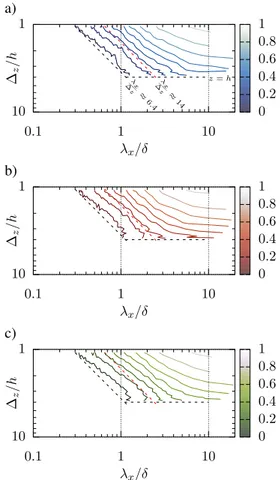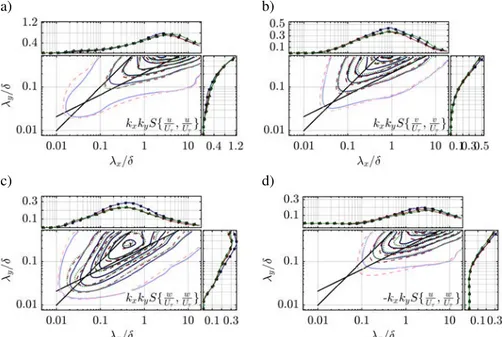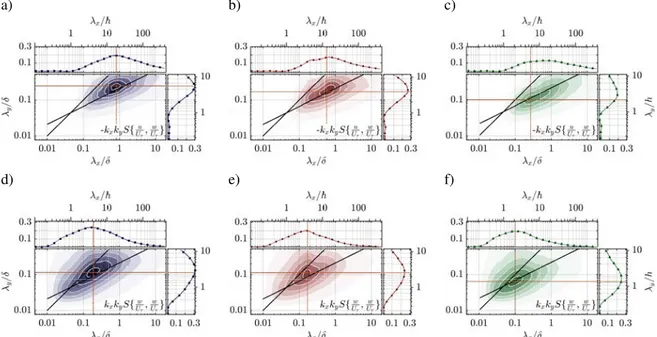OATAO is an open access repository that collects the work of Toulouse
researchers and makes it freely available over the web where possible
Any correspondence concerning this service should be sent
to the repository administrator:
tech-oatao@listes-diff.inp-toulouse.fr
This is an author’s version published in:
http://oatao.univ-toulouse.fr/24604
To cite this version:
Perret, Laurent and Mathis, Romain and Basley, Jérémy
Influence of the plan density of a cube-based canopy on the
structure of the lower atmospheric boundary layer. (2019) In:
11th International Symposium on Turbulence and Shear Flow
Phenomena (TSFP11), 30 July 2019 - 2 August 2019
(Southampton, United Kingdom). (Unpublished).
Official URL:
http://www.tsfp-conference.org/proceedings/proceedings-of-tsfp-11-2019-southampton.html
INFLUENCE OF THE PLAN DENSITY OF A CUBE-BASED CANOPY
ON THE STRUCTURE OF THE LOWER ATMOSPHERIC BOUNDARY
LAYER
Laurent PERRET
LHEEA
UMR 6598 CNRS Centrale Nantes Nantes, France
laurent.perret@ec-nantes.fr
Romain MATHIS
IMFT
Universit ´e de Toulouse, CNRS, INPT, UPS Toulouse, France
romain.mathis@imft.fr
J ´er ´emy BASLEY
Dept. of Aeronautics Imperial College
London, UK j.basley@imperial.ac.uk
ABSTRACT
An experimental investigation of the structure of the boundary-layer developing over an urban-like rough wall is performed considering wall configurations that represent three idealised urban terrains. Both stereoscopic particle image velocimetry and two-point hot-wire data are investi-gated through one- and two-dimensionnal spectral analysis. It is shown that the flow characteristics within the inertial layer appear to be independent from the wall configura-tion. This region is populated with coherent structures of the same type as those found in smooth-wall flows, namely very large-scale motions and large-scale motions, the later showing self-similar features. These coherent structures, whose footprint is mainly visible on the streamwise and spanwise velocity components, also appear to be present in the roughness sublayer. Within the roughness sublayer, the influence of the canopy density shows in the characteristics of the wall-normal velocity component w. The most ener-getic scales in the auto-spectra of w and in the co-spectra between u and w are indeed of the same order of magnitude as the roughness obstacle size and decrease with increasing density. Instead of varying progressively with the packing density, they appear to be constrained by the presence of the canopy for the densest investigated configurations con-sistently with the change of the flow regime reported in the literature.
INTRODUCTION
The vertical structure of turbulent boundary layers de-veloping over dense canopies is strongly impacted, at least in its lower part, by the presence of the roughness obsta-cles (Jim´enez, 2004). The presence of roughness elements on the wall not only alters drastically the near-wall turbu-lent cycle, but also imposes scales of the order of the canopy height within the flow. Therefore, if the height of the rough-ness elements is larger than a few wall units, roughrough-ness is expected to influence the entire boundary layer
struc-Table 1. Characteristics of the boundary layer for the three canopies, where Uτis the friction velocity, ν the kinematic viscosity and superscript+ denoting the inner scaling based on Uτand length scale ν/Uτ.
λp Ue(m/s) Uτ(m/s) δ/h δ+ h+ 6.25% 5.62 0.40 22.4 29 600 1320
25% 5.73 0.42 22.7 32 200 1420 44.4% 5.60 0.36 21.0 24 500 1170 ture (Jim´enez, 2004). In the context of wind flows in ur-ban areas, the influence of the canopy has been shown to be strongly dependent on the height of the obstacles, their arrangement and their spacing. The aim of the present work is to study the influence of varying the plan density λp(see Fig 1, bottom, for definition of λp) of a staggered cube ar-ray modelling the urban canopy on the dynamics of the flow via a detailed analysis of its spectral characteristics. Three values of λp = 6.25, 25 and 44.4% are chosen to cover the three different flow regimes highlighted by Grimmond & Oke (1999), namely the isolated, wake-interference and skimming flow regimes(see Fig. 1, bottom), in order to in-vestigate (i) the influence of the roughness geometry and the variation of the near-wall flow regime on the structure of the flow within the logarithmic layer, (ii) the importance and the footprint of the roughness element dimension on the typical scales of the flow in the roughness sublayer (RSL), and (iii) the effect of varying the obstacle spacing on the structure of the flow within the RSL.
EXPERIMENTAL SETUP
The experiments were conducted in the wind tunnel of the LHEAA, Nantes, France, which has a working sec-tion of dimensions 24 m× 2 m × 2 m (Fig. 1, top). To model the urban boundary layer at high Reynolds number (Tab. 1), a combination of five tapered spires, a fence and a 22 m long fetch of staggered cubes of height h= 50 mm is
Figure 1. Experimental setup: (top) atmospheric wind-tunnel, (bottom) top-view sketch of the three canopies. The shaded region represents the periodic pattern for each case; the area AT such that λp= Ap/ATis delimited by dotted contours.
10−2 10−1 100 10−3 10−2 10−1 100 101 102 (z − d )/ δ λx/δ λp= 6.25% λp= 25% λp= 44.4%
Figure 2. Wall-normal distribution of the pre-multiplied energy spectra kxS(u, u)/U2
τ. The horizontal dashed lines show the wall-normal location zf= 5h for each flow config-uration. Pre-multiplied energy spectra contours have been smoothed on a logarithmically distributed frequency grid and are shown with an increment of 0.2, from 0.2 to 2.8.
employed (see Basley et al., 2018, for full details). Flow measurements have been undertaken at two wall-normal locations, z1= 1.5h and z2= 4h, using three-component-two-dimensional Stereoscopic Particle Image Velocimetry (SPIV) in a streamwise-spanwise plane (Fig. 1, top). These two locations lie within the RSL and in the inertial re-gion, respectively (Basley et al., 2018). The streamwise ex-tent and acquisition frequency of the SPIV velocity fields are such that they can be stitched in the streamwise di-rection by applying Taylor’s hypothesis (see Basley et al., 2018). This SPIV is complemented by two-point single-HWA measurements performed in the RSL and the inertial layer with a fixed point at zf = 5h and a moving probe at 1.25h < zm< 4h (Perret et al., 2019). These data are used to compute the spectral coherence in this region.
a) λ x ∆ z ≈ 6.4 λ x ∆ z ≈ 14 z = h 0.1 1 10 λx/δ 1 10 ∆z /h 0 0.2 0.4 0.6 0.8 1 b) 0.1 1 10 λx/δ 1 10 ∆z /h 0 0.2 0.4 0.6 0.8 1 c) 0.1 1 10 λx/δ 1 10 ∆z /h 0 0.2 0.4 0.6 0.8 1
Figure 3. Spectrograms of coherence γ2(∆z, λx) for λp= (a) 6.25%, (b) 25% and (c) 44.4% with contours from 0.05 to 0.85 with an increment of 0.1. Dashed lines represent two λx/∆z ratios, described in (a).
RESULTS AND DISCUSSION
Two-point HWA data are first analyzed to demonstrate the presence of very large-scale motions (VLSMs) in the outer region of the flow and their superimposition onto the
a) b)
c) d)
Figure 4. Pre-multiplied spectra in streamwise-spanwise plane located in the logarithmic layer (z1= 4h) of (a) u, (b) v and (c) wand (d) co-spectra between u and w.
near-canopy turbulence in the RSL. Contour maps of the pre-multiplied energy spectra of the streamwise velocity component u as a function of the wall-normal distance and λxare shown in figure 2. For the three investigated canopy densities, contrary to what is observed in smooth-wall con-figurations at similar Reynolds numbers, it is not possible to distinguish clear maxima associated on one hand with the near-wall turbulence and, on the other hand, with the larger scales existing in the logarithmic layer. The roughness ob-stacles generate scales much larger than those encountered in the near-wall region in smooth-wall boundary layers, eliminating the expected spectral separation. The overall good agreement between the three different flow configura-tions above(z− d)/δ ≈ 0.1 shows that only the lower part of the flow is affected by the roughness pattern and den-sity. Above this wall-normal location, the most energetic scales correspond to streamwise wavelengths of 3 to 4 δ in agreement with the presence of VLSMs. The wall-normal evolution of the spectral coherence γ2(z
f, zm, λx) is pre-sented in figure 3. For all roughness configurations, coher-ence levels become independent of the considered stream-wise wavelength for λx/δ larger than approximately 10, in agreement with the presence of VLSMs that span the en-tire boundary layer depth and range deep near the wall. For smaller wavelengths, the levels of γ2are scale-dependent. There is indeed a region where the γ2isocontours are lin-ear. This behaviour has been recently linked to the presence of self-similar eddiesin the lower part of the boundary-layer by Baars et al. (2017). Contrary to what has been shown in smooth-wall flows by these authors, a departure of the isocontours from the straight line behaviour for the lowest levels of coherence at large wall-normal separation ∆zis no-ticeable. This might indicate that this range of wavelengths does not correspond to self-similar eddies but to a different type of structures of rather large wall-normal extent (at least 4h, the maximum probe separation), leaving a weak imprint onto the flow. The near-canopy flow is therefore populated of coexisting coherent structures of different type, the ex-act charex-acterisation of which remaining an open question given the limited amount of information available from the
present two-point HWA database.
The spectral signature of the flow is further inves-tigated first in the streamwise-spanwise plane located at z2= 4h, using the Taylor-extended SPIV fluctuating veloc-ity fields. Two-dimensional pre-multiplied (by wave num-bers kx,y= 2π/λx,y) power spectral densities S(u, u), S(v, v) and S(w, w) of the streamwise velocity component, span-wise and wall-normal velocity components, respectively, and the co-spectra uw are shown in figure 4. All spectra and co-spectra obtained at this wall-normal location show a similar spectral signature (figure 4), implying that the influ-ence of the canopy is limited to the RSL and vanishes once above it. In agreement with previous observations, the spec-tral signature of LSMs is mainly carried by the streamwise velocity and consists of a broad-band peak scaling with δ , centred around λx∼ 4δ in the logarithmic layer. The two-dimensional spectrum of u also reflects the anisotropy of the associated structures, the ridge of maximum energy fol-lowing a line close to λx∝λy2. Low and high momentum regions are therefore elongated structures which are wider as they become longer. The spectrum of the spanwise com-ponent shows a peak of energy for λx∼ δ while the spectra S(w, w) corresponds to more compact events with a peak at λx∼ 0.4δ . While the characteristics of the Reynolds shear stress auto-spectra S(uv, uv) (not shown here) seem to be controlled by the most energetic scales of v. The character-istics of S(w, w) and S(u, w) (and S(uw, uw) not shown here) evolve differently and appear to be linked to the presence of ejection and sweep events. In the RSL (at z1= 1.5h), the main peak in S(u, u) is found at λx∼ δ (figure 5 top row) while the peak in S(v, v) is shifted to λx∼ 0.2δ (figure 5 bottom row). There seems to be no direct impact of the canopy geometry on the LSMs which leave their footprint mainly in the streamwise and spanwise velocity compo-nents u and v, respectively, as the wavelength and amplitude of the peaks in S(u, u) and S(v, v) are similar for the three canopies. As in the logarithmic region, the characteristics of the Reynolds shear stress auto-spectra S(uv, uv) seem to be controlled by the most energetic scales of v (not shown here). However, when comparing the logarithmic layer and
a) b) c)
d) e) f)
Figure 5. Pre-multiplied spectra in streamwise-spanwise planes in the RSL (z1= 1.5h) of (top row) u and (bottom row) v. The three canopy configurations with λp=6.25%, 25% and 44.4% are shown in the left, center and right columns, respectively.
a) b) c)
d) e) f)
Figure 6. Pre-multiplied (top row) co-spectra between u and w and (bottom row) spectra of w in streamwise-spanwise planes in the RSL (z1= 1.5h). The three canopy configurations with λp=6.25%, 25% and 44.4% are shown in the left, center and right columns, respectively.
the RSL, the two-dimensional auto-spectra at z1= 1.5h of uand v show the emergence of a secondary peak of slightly smaller energy at larger wavelength in both directions x and y. The emergence of this secondary peak, clearly notice-able in the two-dimensional spectra, is not as visible in the one-dimensional statistics, leading rather to a broader and flatter peak. This suggests that the larger structures existing in the logarithmic layer leave a strong imprint on the flow in the RSL, where exist structures of similar characteristics and energy but of smaller scales.
Pre-multipled spectra of the wall-normal velocity com-ponent w and co-spectra−kxkyS(u, w) between u and w ob-tained in the RSL are shown in figure 6 (bottom and top row, respectively) in order to identify the scales related to
ejec-tions and sweeps and wall-normal transport of momentum. Auto-spectra S(w, w) exhibit smaller typical scales than the two other velocity components, of the order of h, and de-pendent on the canopy pattern, showing that w is associ-ated to canopy interactions and near-wall flow dynamics. There is indeed a clear decrease with increasing λpof the most energetic scales, going from(λx, λy)≈ (4.5h,2.5h) for λp= 6.25%, to (2h, 1.5h) for λp= 44.4%. As far the char-acteristic spanwise scale is concerned, no clear trend with λp (or any characteristic scale of the canopy pattern) has been found, suggesting that the canopy imposes a confine-ment of the flow with a threshold effect in λp, below which the flow structures are not constrained by the canopy geom-etry. In order to investigate the characteristics of coherent
motions driving the wall-normal exchanges, namely sweeps and ejections, co-spectra−kxkyS(u, w) in plane z1are inves-tigated (figures 6, top row). The ridge corresponding to the most energetic scales follows the same law λx∝λy2, con-firming their large-scale interactions with LSMs. In the case of λp= 25% and 44.4%, the co-spectra S(u, w) show a large energy maximum resulting in a flatter or even a double-peaked (when λp= 25%) one-dimensional co-spectra, a feature also noticed for S(u, u). This confirms the organi-zation of ejections and sweeps within streaky LSMs. Over-all, the energy spike associated with interactions between uand w velocity components occurs at decreasing scales when the canopy becomes denser. Since the spectra associ-ated with u were essentially identical for the three canopy densities, such a trend points to smaller and narrower wall-normal motions (w component) interacting with the LSMs when inside the roughness sublayer.
CONCLUSIONS
The influence of the canopy geometry on the spatial or-ganisation of the flow is investigated by addressing the pres-ence of the typical types of coherent structures known to ex-ist in turbulent boundary layers, such as VLSMs and LSMs, but also smaller scale structures related to the presence of sweeps and ejections. The present study shows that, over-all, the characteristics of the large-scales whose footprints appear in the velocity components u and v, are not affected by the change of canopy configuration. In particular, the coexistence of VLSMs, LSMs, the later being characterized by their self-similar behaviour, has been demonstrated. In the logarithmic layer, this population of coherent structures is in agreement with that of smooth-wall boundary layers. Investigation of the two-dimensional spectra obtained in the RSL clearly shows the superimposition of two types of en-ergetic structures, one related to the VLSMs identified in the logarithmic region and above and another one correspond-ing to LSMs with self-similar features. The main
charac-teristics of these structures who leave their imprint in the streamwise and spanwise velocity components were found to be independent of the roughness packing density. How-ever, through the investigation of the spectra of w and the co-spectra between u and w, which relates to the sweep and ejection coherent structures, dynamics of wall-normal mo-tions was found to depend on the roughness spatial arrange-ment. Their most energetic scales appear to be of the order of the canopy height and to decrease with increasing pack-ing density. No controllpack-ing parameter linkpack-ing the canopy morphology and the relevant scales in the wall-normal dy-namics has been yet identified. Instead, a confinement ef-fect of the flow was observed for the densest configuration, suggesting a threshold in terms of canopy density: a more or less sparse canopy arrangement enables or constrains the development of the shear layers emanating from the rough-ness obstacles and the penetration of the boundary layer LSMs closer to the wall.
REFERENCES
Baars, W. J., Hutchins, N. & Marusic, I. 2017 Reynolds number trend of hierarchies and scale interactions in turbulent boundary layers. Phil. Trans. R. Soc. A 375, 20160077.
Basley, J., Perret, L. & Mathis, R. 2018 Spatial modula-tions of kinetic energy in the roughness sublayer. J. Fluid Mech.850, 584–610.
Grimmond, C. S. B. & Oke, T. R. 1999 Aerodynamic prop-erties of urban areas derived from analysis of surface form. Journal of Applied Meteorology 38, 1262–1292. Jim´enez, J 2004 Turbulent flows over rough walls. Ann Rev
Fluid Mech.36, 173–196.
Perret, L., Basley, J., Mathis, R. & Piquet, T. 2019 Atmo-spheric boundary layers over urban-like terrains: influ-ence of the plan density on the roughness sublayer dy-namics. Boundary-Layer Meteorol. 170 (2), 205–234.



